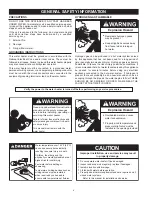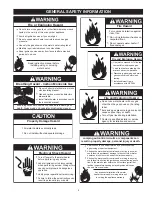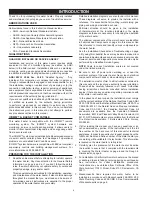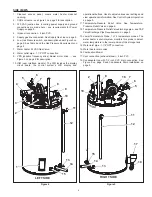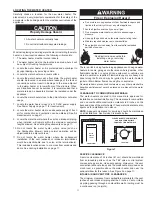
11
locating the water heater
Carefully choose a location for the new water heater. The
placement is a very important consideration for the safety of the
occupants in the building and for the most economical use of the
appliance.
Property Damage Hazard
All water heaters eventually leak.
•
Do not install without adequate drainage.
•
CAUTION
Whether replacing an existing water heater or installing the water
heater in a new location observe the following critical points:
1. The water heater must be located indoors.
2. The water heater must not be located in an area where it will
be subject to freezing temperatures.
3. Locate the water heater so it is protected and not subject to
physical damage by a moving vehicle.
4. Locate the water heater on a level surface.
5. Locate the water heater near a floor drain. The water heater
should be located in an area where leakage of the tank or
connections will not result in damage to the area adjacent
to the water heater or to lower floors of the structure. When
such locations cannot be avoided, it is recommended that a
metal drain pan, adequately drained, be installed under the
appliance.
6. Locate the water heater close to the point of major hot water
usage.
7. Locate the water heater close to a 120 VAC power supply.
See Power Supply on page 11 for requirements.
8. Locate the water heater where an adequate supply of fresh
air for combustion and ventilation can be obtained. See Air
requirements on page 11.
9. Locate the water heater where the vent and intake air piping,
when installed, will remain within the maximum equivalent
lengths allowed. See Venting requirements on page 11.
10. Do not locate the water heater where noise (such as
the Combustion Blower) during normal operation will be
objectionable in adjacent areas.
11. Do not locate the water heater where the subsequent
installation of the vent (exhaust) or intake air terminations
would be objectionable due to noise at the termination(s).
This includes locations close to or across from windows and
doors. See Venting installation on page 11.
Fire or Explosion Hazard
Read instruction manual before
installing, using or servicing
water heater.
Avoid all ignition sources if you smell gas.
Do not store or use gasoline or other flammable vapors and
liquids in the vicinity of this or any other appliance.
Use only the gas shown on the water heater rating label.
Keep ignition sources away from faucets after extended
periods of non-use.
Maintain required clearances to combustibles.
Do not expose water heater controls to excessive gas
pressure.
There is a risk in using fuel burning appliances such as gas water
heaters in rooms, garages or other areas where gasoline, other
flammable liquids or engine driven equipment or vehicles are
stored, operated or repaired. Flammable vapors are heavy and
travel along the floor and may be ignited by the water heater’s
igniter or main Burner flames causing fire or explosion.
Flammable items, pressurized containers or any other potential fire
hazardous articles must never be placed on or adjacent to the water
heater.
clearance to combustible materials
The water heaters covered in this manual are approved for
installation on combustible flooring. The clearance to combustible
and non combustible construction materials is 0 inches on the
back and sides of the water heater. These water heaters are also
approved for installation in an alcove.
note:
Adequate clearance for servicing should be maintained
on all installations. See Service Clearance below.
TOP VIEW
0
0
0
ALCOVE
FRONT VIEW
CLEARANCES TO COMBUSTIBLE
AND NON COMBUSTIBLE
CONSTRUCTION MATERIALS
WATER
HEATER
FRONT
TOP COVER
FRONT
figure 7
serVice clearance
A service clearance of 24 inches (61 cm) should be maintained
from serviceable parts such as the T&P valve, control system
components, gas valve, clean out opening, drain valve, the vent
connection (exhaust elbow) and the condensate drain. Leave as
much room as possible above the water heater and near the
exhaust elbow for this reason. See Figure 9 on page 11.
intake air and Vent pipe clearances
The minimum clearance from combustible materials for the vent
(exhaust) and intake air piping shall be 0 inches. Vent or intake
air piping passing through a combustible wall or ceiling must be
a continuous run (no joints).
Содержание SUF-130- 300/400/500
Страница 75: ...75 ...




